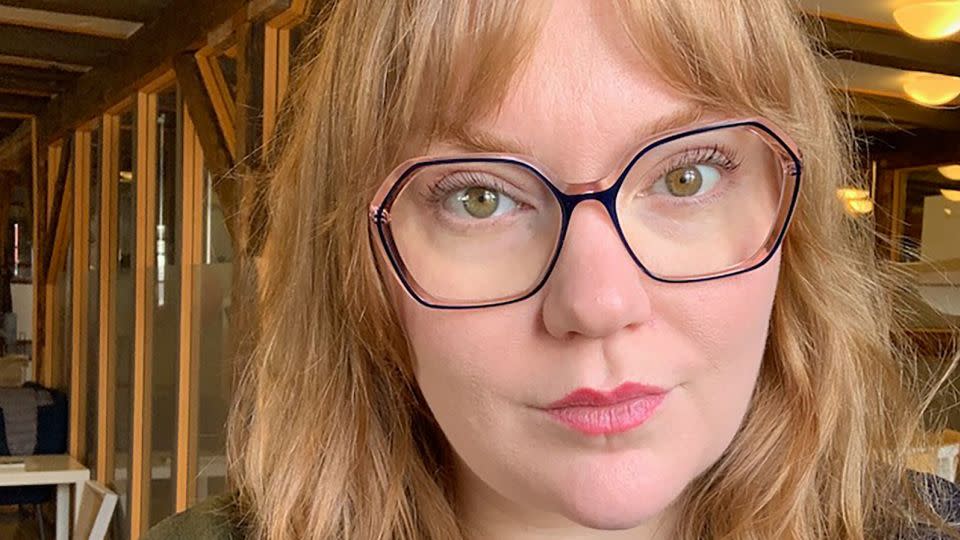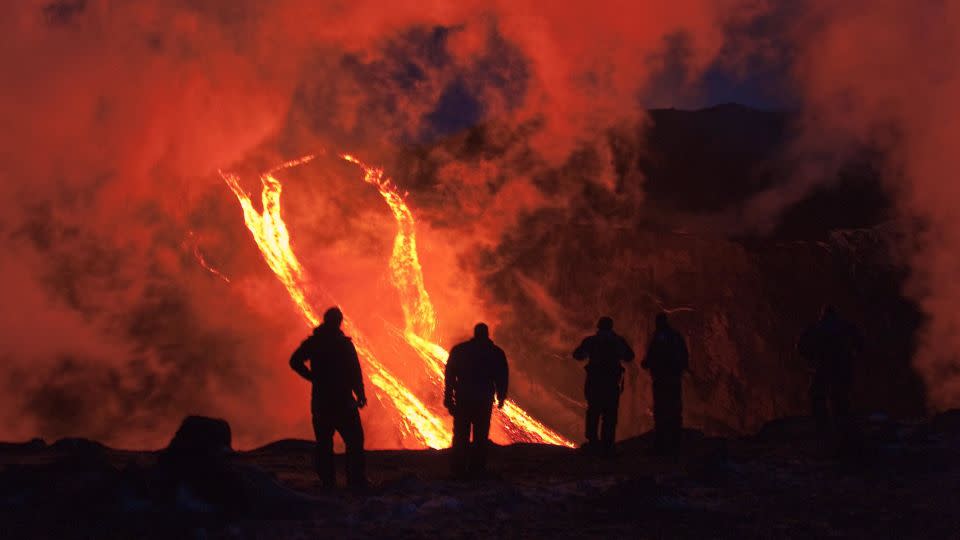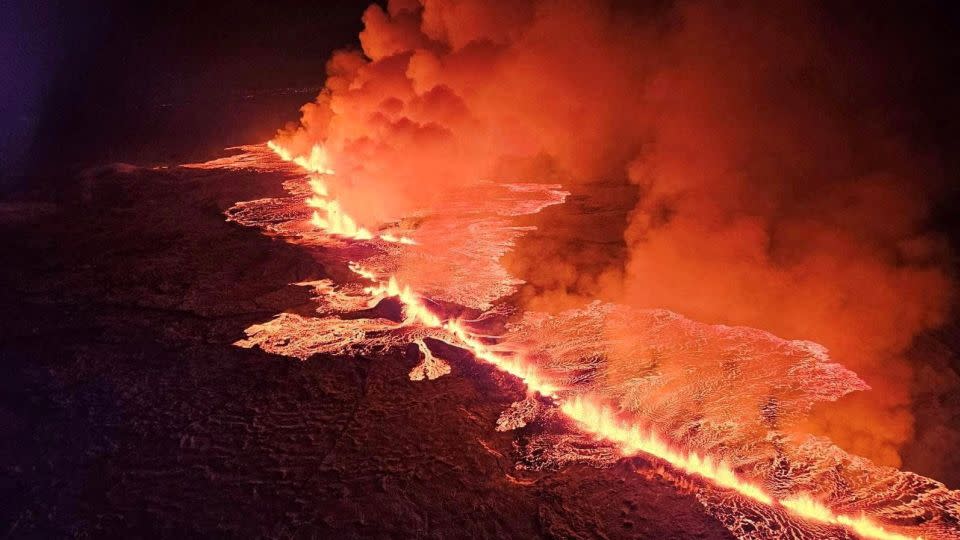Opinion: Iceland’s magnificent nature comes with a monster
Editor’s Note: This article was first published in November and updated on December 19. Catharine Fulton is a Canadian journalist and the editor in chief of The Reykjavik Grapevine. She lives in Reykjavík with her Icelandic partner and their two children. The views expressed in this commentary are her own. Read more CNN Opinion.
The sky to the southwest of Reykjavik began glowing a vibrant orange on the night of December 18 — the Earth is erupting again.

Along the Sundhnúkagígar crater row that last spewed lava some 2,350 years ago, a 4-kilometer fissure has opened up, allowing a curtain of glowing magma to spout into the air and lay down a new layer of volcanic earth at a rate of 200 cubic metres per second.
I remember the first time I experienced an earthquake in Iceland. I ran for the nearest door frame – that’s what you’re supposed to do, right? – under the sloped ceilings of my attic apartment in one of Reykjavík’s iconic bárujárn houses.
I remember being frightfully aware of my fate should the old timber frame and corrugated iron siding decide to simply give way. The shaking ended in seconds, but my knees quaked and my heart raced a while longer.
I remember the first time I saw an active volcano. It was the eruption of Fimmvörðuháls in March 2010; the precursor to the infamous Eyjafjallajökull eruption that began just a month later, spewing forth ash and memes about its impossible-to-pronounce name in equal measure.
In what seems like a daydream to think back on now, I donned a snowsuit, boots, balaclava and helmet and rode a snowmobile over the crunching, crackling, crevassed surface of Sólheimajökull glacier as the sun set to witness a fissure vent spewing glowing fountains of liquid magma high into the air, while a lavafall cascaded down the soot-black side of the newly formed crater.
The site of it was magnificently multisensory. The glow of the lava against the night sky, the waves of heat from the eruption lending an intermittent reprieve from the paralysing cold atop the glacier, the sound of the earth churning. That sound remains the most vivid memory – the sound of the Earth’s pulse.

Such perceptible reminders of the tectonic plates shifting beneath me were not something I was accustomed to. Growing up in the suburbs not far from Toronto, earthquakes and volcanoes were phenomena I’d see on my television screen or described in the pages of old issues of National Geographic.
The closest thing my home came to experiencing an earthquake would have been the result of slamming my bedroom door with a bit too much teen angst.
It wasn’t until I moved to Iceland in March 2009, lured by an opportunity to witness and report on a nation emerging from an economic implosion, that I came to understand and appreciate the explosive qualities of the world.
It’s easy to appreciate the physical beauty of Iceland. With its dearth of dense tree cover, and expanses of sometimes barren and other times moss-covered lava fields, it’s come to be described as “otherworldly” to an almost cliché degree.
But inquisitive visitors soon learn that Icelandic nature must be respected, not only for its preservation, but for their own safety.
It’s something that all Icelanders know. Their country is beautiful, but there’s always the potential for danger.
Icelanders have been reminded of that, seeing residents of Grindavík – a small town 50 kilometres from Reykjavík on the south coast of the Reykjanes peninsula – displaced and staying with friends and family, and at Red Cross emergency shelters around the country. Though the majority of the country is safe, a large swath of this peninsula was evacuated in November as the Icelandic Meteorological Office predicted an imminent eruption. That eruption has now materialized.

It’s perhaps the Icelandic understanding that “this is just the way it is” that saw the people of Grindavík previously stay put when the ground starting shaking in recent years not far from their homes.
The peninsula entered a new volcanic cycle in 2019, with an uptick in earthquakes and measurable ground rise around Fagradalsfjall volcano that culminated in an eruption in March 2021. The cycle of near-constant earthquakes heralding an eruption near Fagradalsfjall repeated in July 2022 and again in July 2023.
News during those seismic and eruptive periods characterised the earthquakes as an inconvenience for nearby Grindavík – nearby, but far enough away from the epicentre of the volcanic action to be well out of danger. The trio of eruptions in as many years were touted as “tourist eruptions” – far from infrastructure and safe to view if you were up for a 10 kilometer hike.
We could feel the larger quakes here in Reykjavík, too. Now, in a sturdier concrete home, I could hear shockwaves approaching like a large truck speeding down the street before slamming into the building with a jolt and rolling on.
The 140,000 of us living in the capital experienced the most recent activity on Reykjanes peninsula much the same. The odd jolt or occasional rumble.
But the most recent burst of seismic activity that began on October 25 was different for the people of Grindavík. Rather than quirky news stories of residents taking sea sickness tablets to cope with the constantly moving Earth, the epicentre had moved beneath the town, described by one resident to The Reykjavík Grapevine as a “monster under their feet.”
That monster was restless, causing tens of thousands of earthquakes before throwing a tantrum on November 10 that repeatedly pulled the ground from under people’s feet. It was late that night that the 3,700 residents of Grindavík were ordered to evacuate.
The monster had burrowed a 15-kilometre lava tunnel that stretched beneath the town. It then promptly went to sleep, leaving the nation to wonder if it was all a false alarm.
But it wasn’t.
Nobody is in harm’s way now and early activity is giving volcanologists hope that the lava flow will spare Grindavík. But the explosive nature of this country straddling tectonic plates, and its potential impact on humans, has once again been brought to the fore.
Not since the Westman Islands awoke to an eruption in their backyard in 1973 has an entire town been evacuated. Now everyone waits and watches and wonders if residents of Grindavík will ever go back home. Will they even want to?
I remember my first volcano. The long and dramatic lead up to the Sundhnúkagígar eruption will cement it in my memory, too.
For more CNN news and newsletters create an account at CNN.com

